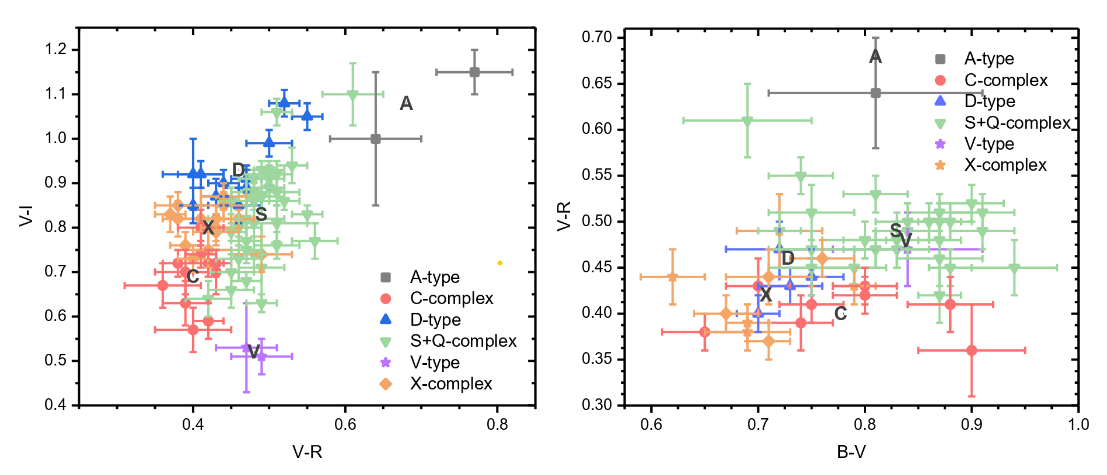Updated dataset of NEOs surface colors obtained within the NEOROCKS project
- 1LESIA, Université Paris Cité, Observatoire de Paris, Université PSL, Sorbonne Université, CNRS, Meudon, France (tetiana.hromakina@obspm.fr)
- 2V.N. Karazin Kharkiv National University, Kharkiv, Ukraine
- 3IMCCE, Observatoire de Paris, CNRS UMRO 8028, PSL Research University, 75014 Paris Cedex, France
- 4Astronomical Institute of the Romanian Academy, Bucharest, Romania
- 5Institut Universitaire de France (IUF), France
- 6INAF – Osservatorio Astronomico di Roma, Italy
- *A full list of authors appears at the end of the abstract
Near-Earth objects (NEOs) provide us with knowledge regarding the formation and evolution of our solar system. By being in close proximity to Earth, we are able to study the physical parameters of smallest asteroids down to several meters. On the flip side, some NEOs create a potential collision hazard to Earth. Such asteroids are classified as Potentially Hazardous asteroids (PHAs) based on their Earth’s MOID value and absolute magnitude.
Here we present the updated dataset of surface colors for NEOs obtained using the 1.2m telescope at the Haute-Provence Observatory (France). The ongoing survey is being carried out in the framework of the NEOROCKS (NEO Rapid Observation, Characterization, and Key Simulations) project funded by the European Union’s Horizon 2020 program. While selecting the targets, special focus was given to PHAs and objects with larger absolute magnitudes.
New observations were performed during four runs between June 2021 and January 2022. As a result, surface colors for 28 NEOs were added to the dataset published in [1], which extended our sample to 79 objects. Figure 1 shows color-color diagrams of the observed objects.
The obtained B-V, V-R, and V-I colors were used to estimate the taxonomic type. To do this we used M4AST service [2], and considered only the main taxonomic classes, such as S– (including Q-type), C-, and X-complexes, and A-, D-, V-types of the DeMeo classification [2]. The distribution of taxonomic classes is shown in Figure 2.
The majority of objects (47%) are classified into S+Q-complex, 19% are classified into X-complex, 14% are classified as both C-complex and D-type asteroids, and, finally, 3 and 4% of objects belong to V- and A-type, respectively. The found distribution is in good agreement with existing works (see, e.g [4,5,6]).

Figure 1. Color-color diagram of the 79 NEOs observed within the NEOROCKS project since November 2020.
Figure 2. Distribution of taxonomic classes in our dataset of NEOs.
References
[1] Hromakina, T., Birlan, M., Barucci, A., et al. A&A, 656, A89, 2021.
[2] Popescu, M., Birlan, M., Nedelcu, D. A&A, 544, 130, 2012.
[3] DeMeo, F., Binzel, R., Stephen M. Slivan, S., Bus, S. Icarus, 202, 160, 2009.
[4] Binzel, R. P., DeMeo, F. E., Turtelboom, E. V., et al. Icarus, 324, 41, 2019.
[5] Devogèle, M., Moskovitz, N., Thirouin, A., et al. AJ, 158, 196, 2019.
[6] Ieva, S., Dotto, E., Mazzotta Epifani, E., et al. A&A, 644, A23, 2020.
Acknowledgments. This project has received funding from the European Union’s Horizon 2020 research and innovation programme under grant agreement No 870403.
E. Dotto, M. Banaszkiewicz, S. Banchi, M.A. Barucci, F. Bernardi, M. Birlan, B. Carry, A. Cellino, J. De Leon, M. Lazzarin, E. Mazzotta Epifani, A. Mediavilla, J. Nomen Torres, D. Perna, E. Perozzi, P. Pravec, C. Snodgrass, C. Teodorescu, S. Anghel, A. Bertolucci, F. Calderini, F. Colas, A. Del Vigna, A. Dell’Oro, A. Di Cecco, L. Dimare, P. Fatka, S. Fornasier, E. Frattin, P. Frosini, M. Fulchignoni, R. Gabryszewski, M. Giardino, A. Giunta, T. Hromakina, J. Huntingford, S. Ieva, J.P. Kotlarz, F. La Forgia, J. Licandro, H. Medeiros, F. Merlin, F. Pinna, G. Polenta, M. Popescu, A. Rozek, P. Scheirich, A. Sergeyev, A. Sonka, G.B. Valsecchi, P. Wajer, A. Zinzi.
How to cite: Hromakina, T., Birlan, M., Barucci, M. A., Fulchignoni, M., Colas, F., Fornasier, S., Merlin, F., Sonka, A., Anghel, S., Perna, D., and Dotto, E. and the NEOROCKS: Updated dataset of NEOs surface colors obtained within the NEOROCKS project, Europlanet Science Congress 2022, Granada, Spain, 18–23 Sep 2022, EPSC2022-364, https://doi.org/10.5194/epsc2022-364, 2022.

